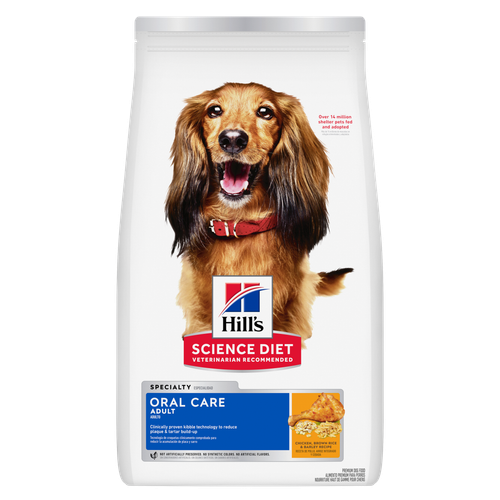
-
Find the right food for your petTake this quiz to see which food may be the best for your furry friend.Find the right food for your petTake this quiz to see which food may be the best for your furry friend.Featured products
 Adult Small Bites Chicken & Barley Recipe Dog Food
Adult Small Bites Chicken & Barley Recipe Dog FoodSupports lean muscle for dogs who prefer smaller kibble
Shop Now Adult Small Bites Lamb Meal & Brown Rice Recipe Dog Food
Adult Small Bites Lamb Meal & Brown Rice Recipe Dog FoodSupports lean muscle, for dogs who prefer smaller kibble
Shop Now Hill's Science Diet Adult Oral Care Chicken, Brown Rice & Barley Recipe Dog Food
Hill's Science Diet Adult Oral Care Chicken, Brown Rice & Barley Recipe Dog FoodClinically proven kibble technology to reduce plaque & tartar build-up
Shop NowFeatured products Adult Perfect Digestion Chicken, Barley & Whole Oats Recipe Dog Food
Adult Perfect Digestion Chicken, Barley & Whole Oats Recipe Dog FoodScience Diet's breakthrough nutrition supports ultimate digestive well-being & healthy microbiome
Shop Now Adult Perfect Digestion Salmon, Whole Oats, and Brown Rice Recipe Dog Food
Adult Perfect Digestion Salmon, Whole Oats, and Brown Rice Recipe Dog FoodScience Diet's breakthrough nutrition supports ultimate digestive well-being & healthy microbiome
Shop Now Hill's Science Diet Adult 7+ Healthy Cuisine Roasted Chicken & Rice Medley Cat Food
Hill's Science Diet Adult 7+ Healthy Cuisine Roasted Chicken & Rice Medley Cat FoodDelicious roasted chicken and rice in a mouthwatering sauce
Shop Now -
Featured articles
 The Incredible Science Behind Your Pet's Microbiome
The Incredible Science Behind Your Pet's MicrobiomeLearn what a pet's microbiome is, how it contributes to your pet's gut & overall health, and why nutrition is important in maintaining healthy microbiomes.
Read More Pet Food Storage Tips
Pet Food Storage TipsDiscover how and where to store your dry, as well as canned, dog and cat food. Learn how to find the "best before" dates on all Hill's pet food packaging.
Read More Water
WaterDiscover why water is the most important nutrient for your dog or cat to live a healthy life. Find out how much water your pet should consume each day.
Read More -


Fleas and ticks are not just a nuisance, they're also a real threat to your pet's health. Dogs and cats not treated with flea and tick medication, either in the form of a topical treatment or a flea and tick pill, can suffer everything from flea allergy dermatitis (which causes your animal to bite and scratch himself and sometimes lose his hair) to tapeworms.
Since a single female flea can produce up to 2,000 eggs in her three-week lifespan, a dog can become infested quickly. Tick bites are even more dangerous. A single tick bite can transmit Lyme disease, Rocky Mountain spotted fever, tularemia, ehrlichiosis and other diseases. Signs and symptoms of tick-borne illnesses may take anywhere from 7 to 21 or more days to appear, according to the Centers for Disease Control.
Luckily, there are many types of flea and tick medications available to stop these tiny terrors from making their home on your dog or cat. The most popular kind of effective treatment is a topical medication generally applied once a month. A newer preventive measure is a flea and tick pill. Are you curious about which of the two methods might work best for your pet? Here's a look at the pros and cons of each type of treatment.
Oral Treatments
Oral flea and tick medication treatments—which come as chewables or pills — are ingested by your pet, rather than applied to his body. The medicine is transmitted to adult fleas when they bite your pet. There are different active chemicals used in different flea and tick pill medications, some of which last a few days and others that last a month. The most common active chemicals in oral treatments include:
- Lufenuron: This compound does not kill adult fleas. Instead, any larvae produced by the adults will not survive. Medications with this chemical are approved by the Federal Drug Administration (FDA) for dogs and cats. It does not kill ticks.
- Spinosad: Spinosad only kills adult fleas, not ticks. It works by overstimulating the flea's nervous system, which causes its death. Medicines with spinosad are not recommended for dogs with epilepsy. Harvard Medical School also reports that the FDA approved a topical medication called Natroba for humans as a head lice treatment. The active chemical in Natroba? Spinosad.
- Nitenpyram: This fast-acting insecticide kills adult fleas in as little as thirty minutes. It doesn't have long-term effect, so it shouldn't be used for continuous flea control. Instead, it might be an option if you are planning a short-term trip to an area where you expect fleas will be present, such as a boarding kennel or a dog park. It is worth noting that most vets use this to kill fleas quickly, rather than use it as a preventative solution. It is approved for use by the FDA in cats and dogs, and it also kills ticks.
Topical Treatments
Topical flea and tick medication, also called "spot on" medications, are generally applied between the pet's shoulder blades so the pet can't lick it off. Most topical medications last a month. Some topical medications not only kill fleas and ticks, they also repel them. The most common active chemicals in topical medications are:
- Fipronil: Fipronil works by attacking the nervous system of the parasite to paralyze fleas and ticks to ultimately kill them. Fipronil spreads over the cat or dog through body oils in about a day. It releases over time — usually about a month. It is approved by the Environmental Protection Agency (EPA) for use on cats and dogs.
- Imidacloprid: This ingredient kills fleas by disrupting the nervous system. It kills both adult and larval stage fleas that come in contact with the pet. It is approved by the EPA for use on cats and dogs.
- Pyrethroids: You may see pyrethroids on the list of active ingredients under a few different names. It is an organic compound derived from a flower, which makes it popular among pet owners who prefer all-natural products, though there are also synthetic pyrethroids that some manufacturers prefer because they are more stable and last longer. Pyrethroids are not approved for use on cats by the EPA, and should be used with caution on small dogs, and never in households with cats as it is extremely toxic to felines. Products with pyrethroids kill fleas, ticks and mites.


Tasty Tips
Young pets may need several visits in their first year for vaccinations. Adult pets generally benefit from annual check-ups, while senior or special-needs pets might require more frequent visits.
Effectiveness
Some pet owners complain that flea and tick medications don't work as well as advertised, but veterinarians and flea and tick medication producers told The New York Times that when the products are used correctly, they do work. Problems crop up when pet owners make mistakes in applications or have unrealistic expectations about how the treatments work.
Veterinarian Michael Murray told The Times that since fleas reproduce so quickly, by the time you notice them on your dog they could have produced two or three generations of offspring.
"That means by the time you start treating your pet you've got this massive amount of flea biomass in your home, flea larvae and pupae," Murray says. "It can take as little as three weeks or as long as several months for that to run its course."
A study published in Veterinary Parasitology seems to back up the veterinarians and flea product makers. The ninety-day study found that topicals were 88.4 percent effective, while oral treatments were 99.9 percent effective. There were 128 dogs from five states involved in the study.
Whatever your choice in flea and tick preventative, it is important when buying any medication that you make sure that your vet has approved the medication's use in your pet and that you are purchasing it from a reputable source. It is also important to consider heartworm treatments. If your chosen flea medication doesn't protect against heartworm, make sure to talk to your vet about how to protect your pet.
If you are wondering which treatment is the best option, please consult with your veterinarian. They will ensure to get your pet on the correct treatment plan. If you need to find a veterinarian in your area, please visit our Vet finder.


Kara Murphy is a freelance writer and pet parent who lives in Erie, Pa. She has a goldendoodle named Maddie.
Related products

Delicious roasted chicken and rice in a mouthwatering sauce

Clinically proven kibble technology to reduce plaque & tartar build-up

Science Diet's breakthrough nutrition supports ultimate digestive well-being & healthy microbiome

Science Diet's breakthrough nutrition supports ultimate digestive well-being & healthy microbiome
Related articles

Discover how and where to store your dry, as well as canned, dog and cat food. Learn how to find the "best before" dates on all Hill's pet food packaging.

Discover how antioxidants fight against free radicals in your dog or cat's body, and why they are so important to your pet's diet.

Discover why water is the most important nutrient for your dog or cat to live a healthy life. Find out how much water your pet should consume each day.

Learn what a pet's microbiome is, how it contributes to your pet's gut & overall health, and why nutrition is important in maintaining healthy microbiomes.

Put your pet on a diet without them knowing
Our low calorie formula helps you control your pet's weight. It's packed with high-quality protein for building lean muscles, and made with purposeful ingredients for a flavorful, nutritious meal. Clinically proven antioxidants, Vitamin C+E, help promote a healthy immune system.
Put your pet on a diet without them knowing
Our low calorie formula helps you control your pet's weight. It's packed with high-quality protein for building lean muscles, and made with purposeful ingredients for a flavorful, nutritious meal. Clinically proven antioxidants, Vitamin C+E, help promote a healthy immune system.


